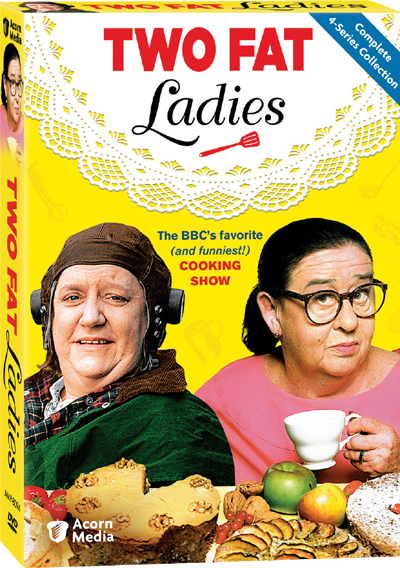 Kathleen wrote this with her sister, Kage Baker.
Kathleen wrote this with her sister, Kage Baker.
They were perfect role models.
They were unashamedly fat, unapologetically old, defiantly erudite, determinedly eccentric, and they roared around the UK on an antique motorcycle with sidecar without giving a damn whether anyone approved of them. They had lived wildly and widely — Jennifer had been expelled from convent school, had traveled all over the world and once gone tiger-shooting with a maharaja, whereas Clarissa was a former solicitor who had survived a rough life and, with flair and grace, had pulled herself out of the pits of Hell. Between them there was just about nothing they hadn’t done.
They were bloody good cooks, too.
Jennifer Paterson was the elder and more outgoing, often bursting into comic song in the middle of an anecdote or recipe, which could be startling because she generally sounded more like Louis Armstrong than Marie Lloyd. Her makeup — flawless 1940s crimson lipstick, flawless crimson fingernails — was somewhat offset by immense thick spectacles through which she peered vaguely. She smoked cigarettes and was fond of the occasional cocktail.
Clarissa Dickson Wright never bothered with makeup. She was a survivor, with a quiet dry sense of humor. She had been the youngest woman ever called to the Bar. She had been an alcoholic and squandered an inheritance amounting to millions of pounds. She had occasionally been homeless. Like Jennifer, she had bounced through life taking a number of different jobs to make ends meet, during one of which she shot a peacock that had intruded into a cabbage patch.
By middle age both of them had established themselves as good and knowledgeable cooks. When the BBC was putting together a new cooking program, the show’s producer, Patricia Llewellyn, called both ladies, introduced them to each other, and shot a pilot for the show. Llewellyn’s co-workers were horrified — who were these rowdy old baggages, and why would anyone cast them as “television presenters” in the face of rules that stated TV personalities must be slim and posh? Fortunately the show was picked up despite their disapproval, and ran for four seasons until Jennifer’s untimely death in 1999.
The Two Fat Ladies was something of a travelogue: our heroines would ride around the UK to cook dinner for others in locations as diverse as Westminster Cathedral, an army barracks, a brewery and a convent in Ireland. Lacrosse teams, a boys’ choir, lumberjacks and bargemen all dined with gusto on multiple courses that had been cooked with generous helpings of butter and cream. It horrified the lettuce-and-lentils set, and indeed the Ladies came in for their share of carping from people who felt they were single-handedly undermining the health of the British public. To which, more often than not, the response from Jennifer was a frosty stare and a resounding pronouncement of “Rrrrrrubbish!”
Though the main and ultimate charm of the show is the Ladies themselves, the food is real and wonderful. If you can cook, try stretching your horizons with these expert recipes — if you can’t, at least order some of the more interesting dishes on your nights out. During thoroughly lived lives, the Ladies had collected recipes from a multitude of places and times, and you never knew what they were about to serve up. It might be an Asturian Bean and Sausage Soup, Crab Fritters, Rabbit Isabel, Crème Pierre le Grand, Medallions of Venison with Blackberries, or Hoppin’ John. You never knew what they’d say, either, as they’d chat and reminisce while chopping shallots or slicing oranges: Jennifer recalling the time she’d had to smuggle a dead friend’s ashes home from Bahrain, wrapped in her petticoat, or Clarissa explaining the amount of steady kneading required for the pastry in a Quercyan Apple Tart and remarking, demurely, that Quercyan girls were therefore in great demand as wives.
However, if you do try the recipes (or “receipts” as Jennifer called them) at home, take copious notes — the Ladies don’t always bother with standard measurements, being of the “dab, bit and huge amazing glob” school of additives. Be prepared to make the intimate acquaintance of cream, double and triple cream, and real butter. Google a translation of the difference between the heat marks on a British oven, and the degrees Fahrenheit dials we use. With these few preparations, you can make any of their recipes, and your life will be richer.
Previously only available on VHS cassette and incomplete, the Ladies’ full twenty-four episode odyssey can now be found in a handsome boxed set of DVDs from Acorn Media. This DVD compilation is beautifully done, including many delicious little bits that were cut when the shows were initially shown in the US. Sometimes they seem to have been edited for content — the Ladies’ remarks are occasionally difficult for a non-Anglophone (and we mean UK English, not American) to comprehend. Other edits seem to have been made to excise some of the Ladies’ saltier commentary, or to prevent squeamish Americans from being horrified seeing at the insides of some beastie destined for a glorious incarnation as an entree. But most, shamefully, were probably shortened to make room for a commercial for Burger King or TGI Friday’s. The complete shows are even more delightful than we remembered.
Extras include a small booklet of recipes with measurements (try the Pumpkin Soup from the Jamaican Christmas special!), bios of both Jennifer and Clarissa, and a tribute to Jennifer recorded after her death. This last feature should be depressing, but isn’t. The viewer comes away marveling that one life should have been lived so vividly, with such enthusiasm, and with such bravery on learning it had to end. If anyone ever skidded sideways into Heaven, mojito in one hand, cigarette in the other, whooping joyfully, it would have been Jennifer Paterson.
(Acorn Media, 2008)
